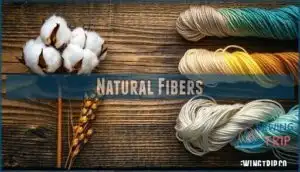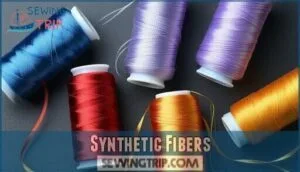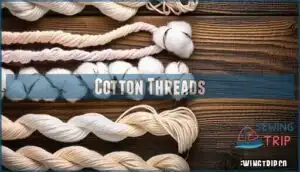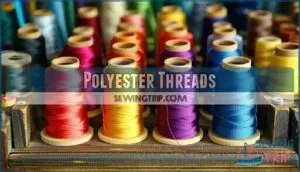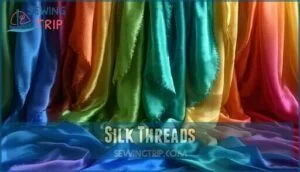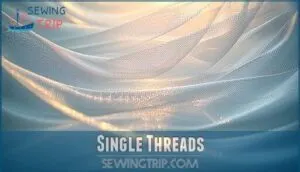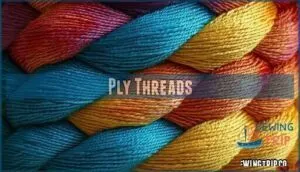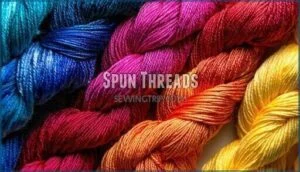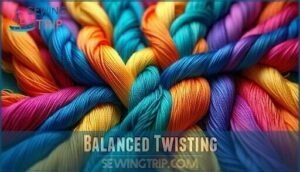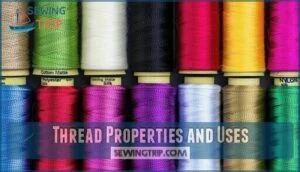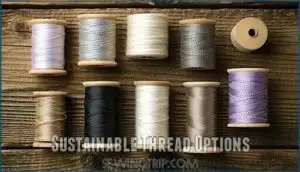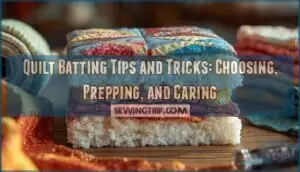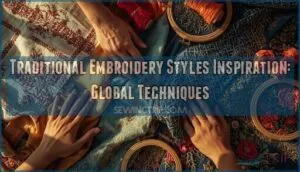This site is supported by our readers. We may earn a commission, at no cost to you, if you purchase through links.
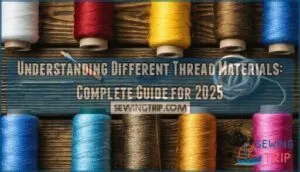 Understanding different thread materials starts with knowing your basics.
Understanding different thread materials starts with knowing your basics.
Cotton resists heat but breaks down over time, while polyester lasts forever but won’t absorb moisture like cotton does.
Nylon stretches like a rubber band and bounces back, but it’ll melt under your iron.
Silk gives you strength with finesse, and wool wicks moisture while taking dye beautifully.
Rayon shines bright but lacks muscle.
Think of thread choice like picking the right tool for the job – you wouldn’t use a hammer to fix a watch.
Each material has its sweet spot, and knowing when to use which one separates beginners from pros.
Table Of Contents
Key Takeaways
- Match thread material to your project needs – You’ll get better results when you choose cotton for heat resistance and natural fabrics, polyester for durability and color retention, silk for delicate work with elegant strength, and nylon for heavy-duty applications that need stretch and recovery.
- Understand thread weight affects your outcome – You need to remember that lower numbers mean thicker threads for heavy fabrics, while higher numbers indicate finer threads for delicate materials, and matching thread weight to fabric thickness prevents puckering and breakage.
- Consider thread construction for optimal performance – You’ll find that single threads work best for lightweight fabrics, ply threads offer superior strength for heavy-duty projects, and spun threads provide excellent versatility by combining different fibers for enhanced durability.
- Choose sustainable options when possible – You can reduce environmental impact by selecting eco-friendly threads like recycled polyester from plastic bottles, organic cotton grown without harmful chemicals, or biodegradable options that break down naturally after use.
Thread Material Types
You’ll find thread materials fall into two main groups: natural fibers like cotton and silk that come from plants and animals, and synthetic fibers like polyester and nylon that are made in factories.
Each material has its own strengths and weaknesses, so picking the right one depends on what you’re sewing and how long you need it to last.
Natural Fibers
Natural fibers bring Mother Nature’s touch to your sewing projects.
These thread materials come from plants and animals, offering unique characteristics that synthetic options can’t match.
Here’s what makes them special:
- Cotton thread provides excellent natural durability and easy dyeing processes
- Silk thread delivers premium strength with beautiful sheen
- Material blends combine fiber sourcing benefits while maintaining biodegradability
Synthetic Fibers
While natural options have their place, synthetic fibers dominate modern sewing with their engineered strength.
Polyester thread leads the pack, offering durability and color retention. Nylon threads excel in heavy-duty applications, while acrylic fibers provide wool-like softness.
Rayon properties blend natural feel with synthetic performance. However, microfiber shedding raises environmental concerns.
Synthetic blends combine multiple materials for superior results.
Cotton Threads
Cotton threads remain the gold standard for many sewers thanks to their natural fiber strength and versatility.
You’ll find Egyptian Cotton and Mercerized Cotton offering superior quality, while Cotton Blends provide enhanced durability.
These thread materials work perfectly for Quilting Cotton projects, delivering reliable results.
For best results, make certain you match thread weight to fabric thickness.
Understanding thread fiber content helps you choose between basic cotton threads and premium Thread Finishes for your specific needs, ensuring you get the best results.
Polyester Threads
Across the board, you’ll find polyester thread materials dominating modern sewing thanks to their synthetic thread properties.
These workhorses deliver exceptional polyester durability while maintaining superior color retention and UV resistance that cotton simply can’t match. Its inherent tensile strength makes it a reliable choice.
- Thread finishes include matte, trilobal, and high-sheen options for different project needs
- Filament count affects strength – higher counts create smoother, stronger polyester thread performance
- Thread fiber content stays consistent, preventing shrinkage and ensuring long-lasting results
Silk Threads
While polyester dominates modern sewing, silk thread offers unmatched elegance and performance.
You’ll find this luxurious natural fiber creates stunning results for delicate fabrics and decorative work. Silk production yields threads with exceptional sheen and drape, making them perfect for high-end garments and embroidery projects that demand premium quality.
Many artisans use silk for detailed threadwork projects.
| Silk Properties | Thread Applications |
|---|---|
| Natural sheen | Evening wear |
| Fine denier | Embroidery work |
| Smooth texture | Lingerie construction |
| Color vibrancy | Decorative stitching |
| Flexible strength | Quilting details |
Thread Construction Methods
When you’re choosing thread for your project, you’ll need to understand how manufacturers build different types of thread structures.
The way threads are twisted, spun, or combined affects everything from strength to how smoothly they run through your sewing machine.
Single Threads
Single threads represent the simplest thread construction you’ll encounter. These Monofilament Threads consist of one continuous strand without twisting or plying. Their Single-Ply Strength comes from the base material’s inherent properties rather than structural reinforcement.
Here’s what makes Untwisted Threads unique:
- Smooth surface texture reduces fabric friction during sewing
- Consistent diameter throughout the entire thread length
- Minimal bulk when passing through tight weave fabrics
- Clear visibility of individual Filament Properties under magnification
Single Thread Uses include lightweight fabrics, delicate embroidery, and precision work where thread bulk matters.
Ply Threads
You’ll find ply threads work differently than their single counterparts.
These sewing threads combine multiple strands twisted together, creating superior thread durability through balanced ply construction.
The twisting techniques determine ply thread strength – tighter twists offer more resilience for heavy-duty projects.
Thread construction affects thread types substantially, with ply thread uses ranging from upholstery to decorative stitching where extra strength matters most.
For delicate fabrics, consider using lightweight thread options.
Spun Threads
You’ll love how spun threads offer incredible versatility for your sewing projects.
These threads combine different fibers through a spinning process, creating stronger, more durable sewing threads than single-strand options.
Spun thread manufacturing blends natural fibers with synthetic threads, giving you excellent spun thread durability.
Popular spun thread applications include quilting and heavy-duty stitching, while various spun thread finishes enhance performance across different thread types.
Balanced Twisting
When you’re twisting multiple strands together, achieving thread balance prevents that annoying tendency to kink up on itself.
You’ll get better twist stability and uniformity benefits by controlling torque reduction during plying techniques.
This balanced approach boosts thread performance substantially – your thread tension stays consistent, thread strength improves, and overall thread durability increases.
It’s like teaching your threads to play nicely together.
Thread Properties and Uses
When you’re picking thread for your next project, you’ll need to understand how different properties like strength, weight, and finish affect what you can accomplish.
These key characteristics determine whether your thread will handle heavy-duty work or delicate embroidery, so knowing them helps you avoid frustrating breaks and messy results.
Tensile Strength
When you’re evaluating thread strength, you’re basically testing how much pulling force your thread can handle before snapping.
Different thread types showcase varying thread durability based on their material composition and construction methods.
- Strength Testing measures maximum load capacity before thread failure occurs
- Material Composition directly impacts thread resilience and overall performance ratings
- Load Capacity varies substantially between cotton, polyester, and specialty thread options
- Weaving Impact affects how threads distribute stress during actual sewing applications
Thread Weight
You’ll measure thread weight using numbers that seem backward at first glance.
Higher numbers mean thinner threads, while lower numbers indicate thicker ones.
Thread thickness directly affects fabric compatibility and stitch appearance on your projects.
Heavier fabrics need lower weight numbers for strength, while delicate materials require higher numbers.
Proper thread selection makes certain your tension adjustment works smoothly across different thread types and sizes.
For general sewing, a good choice is 40-50 weight threads.
Denier System
Beyond traditional thread measurement systems, you’ll find the denier system measures thread weight by calculating mass per 9,000 meters of filament.
This denier calculation helps determine fabric weight and thread applications more precisely than basic sizing.
Understanding filament count alongside thread denier reveals performance impact, making the tex number system and thread tex measurements essential for professional results.
Fine Threads
Fine threads are your go-to choice for delicate fabrics like silk and chiffon.
These lightweight thread types require careful needle compatibility and tension adjustments to achieve perfect stitch appearance.
Thread selection becomes critical here – you’ll want thread size between 50-80 weight for specialized applications.
Remember, fine thread weight demands gentle handling but delivers beautiful, nearly invisible seams on lightweight materials.
Glazed Cotton
Through the glazing process, you’ll transform ordinary cotton thread into something that shines like silk.
Cotton mercerization strengthens the fibers before glazed durability coating adds that signature luster.
Here’s what makes glazed cotton special:
- Thread finish resists fraying and tangling during machine sewing
- Finishing techniques create smoother stitches than regular cotton threads
- Thread manufacturing produces stronger seams for quilting projects
Sustainable Thread Options
You’ll find that choosing eco-friendly threads helps reduce your environmental impact while maintaining the quality your projects need.
These sustainable options include recycled polyester, organic cotton, and biodegradable materials that break down naturally after use.
Eco-Friendly Materials
You can make a real difference with your thread choices.
Eco-friendly threads from sustainable sourcing help reduce waste through ethical production methods.
Natural fibers like organic cotton and hemp offer biodegradable options that support the circular economy.
These sustainable sewing materials break down naturally, unlike synthetic threads that persist in landfills for decades.
You can find various thread options online.
Recycled Polyester
Recycled polyester threads come from old plastic bottles through rPET production, giving waste new life.
From trash to treasure – every recycled thread gives plastic bottles a second chance at greatness.
The recycling process transforms bottles into strong synthetic threads with impressive rPET durability. These eco-friendly threads match virgin polyester’s performance while delivering significant environmental benefits through reduced energy use and waste diversion.
While beneficial, it’s noteworthy that rPET sheds microplastics during washing.
Why recycled polyester threads matter:
- Ocean savior – Every rPET thread keeps plastic bottles from polluting our seas
- Energy champion – Uses 30% less energy than making new polyester thread
- Wallet-friendly – Costs less while performing just as well as virgin materials
- Future builder – Your thread recycling choice helps create a cleaner tomorrow
Organic Cotton
You’ll find organic cotton thread offers superior thread material quality without harmful pesticides or chemicals.
Cotton farming for organic certification requires strict environmental standards, making it a premium thread material selection.
These textile applications provide excellent thread material properties including natural breathability and softness.
Environmental benefits include reduced water pollution and soil preservation.
Future trends show growing demand for sustainable cotton thread options.
Biodegradable Threads
Biodegradable threads revolutionize sustainable sewing by breaking down naturally after use.
These eco-friendly threads offer excellent thread composition options for environmentally conscious sewers.
Consider these composting threads for your next project:
- Lyocell fibers – Made from wood pulp, decompose within months
- Natural cotton thread – Classic biodegradable option with reliable strength
- Silk threads – Premium biodegradable choice for delicate work
Their degradation speed varies by manufacturing process and applications.
Some threads, like polyester, can take over 200 years to decompose.
Environmental Impact
Thread production creates serious textile pollution through chemical runoff and energy consumption.
Synthetic threads cause microfiber shedding when washed, contaminating waterways with tiny plastic particles. Biodegradability issues mean conventional threads persist in landfills for decades.
You can reduce production impacts by choosing ecofriendly threads and ecocconscious materials. Sustainable sewing practices and sustainable alternatives help protect our planet’s future.
Choosing Right Thread
You’ll face countless thread options when you start your next sewing project, and picking the wrong one can turn your masterpiece into a tangled mess.
The secret lies in matching your thread’s material, weight, and strength to your fabric type and project goals, just like choosing the right tool for each job, which is a complete concept to grasp for a successful sewing project.
Factors Affecting Thread Choice
When you’re picking thread, several key factors shape your decision.
Your project purpose drives everything – quilting needs different thread strength than embroidery.
Consider your sewing method too, since machine settings affect stitch appearance.
Here’s what matters most:
- Needle compatibility – Match thread types to your needle size for smooth stitching
- Machine tension – Cotton thread and polyester thread behave differently under tension
- Fabric weight – Heavy fabrics demand stronger threads for lasting results
Material Selection
Smart thread material choices depend on understanding your project’s needs first.
Consider load types, application specifics, and assembly methods when selecting materials.
Cotton works well for lightweight fabrics, while polyester handles heavy-duty tasks.
Thread compatibility with your fabric prevents puckering and breakage.
Match thread advantages to your specific requirements—silk for delicate work, nylon for strength, ensuring proper tolerances throughout.
Selecting the right thread also involves matching needle size to avoid tension issues, which is crucial for proper tolerances.
Environmental Factors
Your project’s environment plays a major role in thread performance.
UV Degradation weakens fibers exposed to sunlight, while Chemical Exposure from cleaning products can break down materials.
Temperature Effects cause expansion and contraction, affecting tension.
Humidity Impact leads to swelling or shrinking.
Consider Abrasion Resistance for high-wear areas.
Ecofriendly threads offer better thread sustainability and environmental impact control.
Proper Thread Selection and Design
Beyond just picking any thread off the shelf, you’ll need to think about how all the pieces work together.
Smart thread selection means matching your thread material performance to your specific needs, while thread design factors guarantee everything runs smoothly.
Here’s your essential checklist:
- Stitch Compatibility – Match thread types to your intended stitch pattern
- Needle Size – Coordinate thread weight with proper needle selection
- Machine Tension – Adjust settings based on thread material characteristics
- Project Purpose – Consider durability needs and final use requirements
- Thread Finishes – Select appropriate coatings for fabric matching success
Thread Size and Matching
Thread weight determines your stitch appearance and project outcomes.
You’ll match thread size to fabric weight – lightweight fabrics need fine threads, heavy materials require thicker ones.
Thread diameter affects needle size selection and machine tension settings.
Proper fabric compatibility prevents puckering and breakage.
When thread selection aligns with fabric matching principles, you’ll achieve professional results every time, by ensuring proper fabric compatibility and understanding that thread weight is crucial.
Frequently Asked Questions (FAQs)
Which is thicker, 40 wt or 50 wt thread?
Don’t judge a book by its cover—40 wt thread is actually thicker than 50 wt thread.
You’ll find that lower weight numbers mean thicker threads, while higher numbers indicate finer, thinner threads for delicate work.
How to know what thread to use?
Consider your fabric type, project purpose, and sewing method first.
Match thread weight to fabric thickness, choose polyester for durability or cotton for natural fibers.
Make certain your needle size complements the thread.
How do I identify different threads?
Identifying threads is easier than rocket science!
Check the label first – it’ll show material type and weight.
Feel the texture: cotton’s rough, polyester’s smooth, silk’s luxurious.
Use calipers for diameter measurements.
How do I store threads to prevent deterioration?
Store your threads in a cool, dry place away from direct sunlight.
Use airtight containers or thread organizers to prevent dust accumulation.
Keep different materials separated, and avoid extreme temperatures that’ll weaken fibers over time, ensuring the longevity of your threads by storing them properly to prevent damage from dust.
What causes thread to break during sewing?
Nothing’s more frustrating than constantly snapping thread! You’re likely dealing with incorrect tension settings, using the wrong needle size, threading errors, poor-quality thread, or sewing too fast through thick fabrics.
Can different thread materials be mixed together?
You can mix different thread materials, but it’s tricky.
Polyester and cotton have different stretch rates, so seams might pucker.
Stick with similar materials for best results, or test combinations first.
How do I identify unknown thread material?
Like a detective examining clues, you’ll burn-test a small sample—cotton smells like paper, polyester melts into hard beads, and silk sizzles then stops.
Check the thread’s sheen, stretch, and texture for confirmation.
Whats the shelf life of various threads?
You’ll find polyester and nylon threads last 2-5 years when stored properly, while cotton and silk degrade faster at 1-3 years.
Heat, moisture, and UV light accelerate breakdown, so keep them cool and dry.
Conclusion
Did you know that choosing the wrong thread causes 40% of sewing project failures?
Understanding different thread materials transforms your projects from frustrating disasters into professional successes. You’ve learned how cotton provides heat resistance, polyester offers durability, and silk delivers elegant strength.
Remember to match your thread to your fabric and project needs. Whether you’re hand-stitching a quilt or machine-embroidering a logo, the right thread material makes all the difference in your final results, leading to elegant strength.
- https://www.superiorthreads.com/education/thread-characteristics
- https://threadsmonthly.com/sewing-thread-types-uses
- https://www.sewingpartsonline.com/blogs/education/ultimate-thread-reference-guide-2
- https://en.wikipedia.org/wiki/Thread_(yarn
- https://www.aftrglohernando.com/blog/pdo-thread-lift-innovations-2025-emerging-trends-and-future-directions-in-facial-rejuvenation

